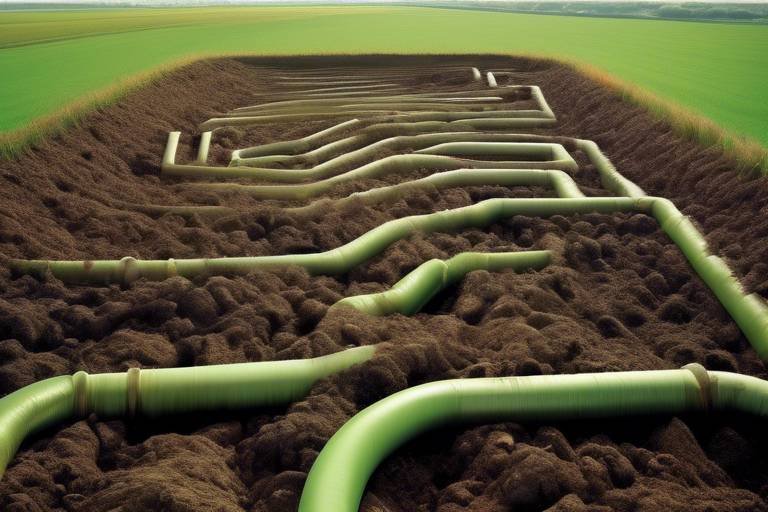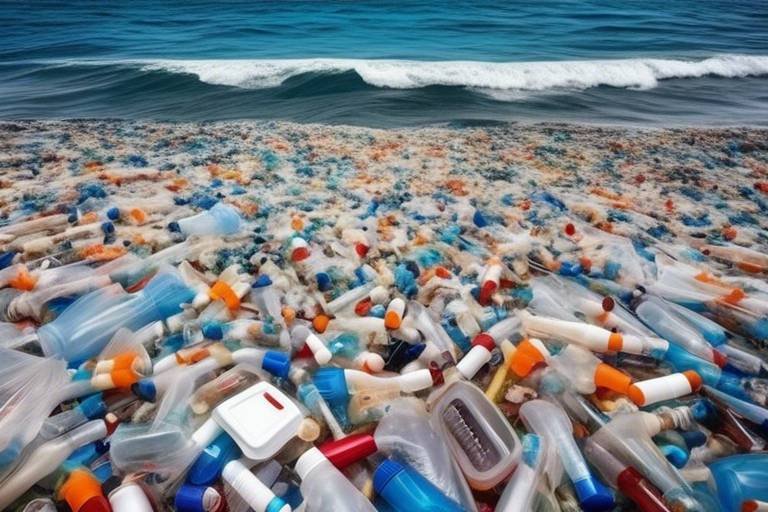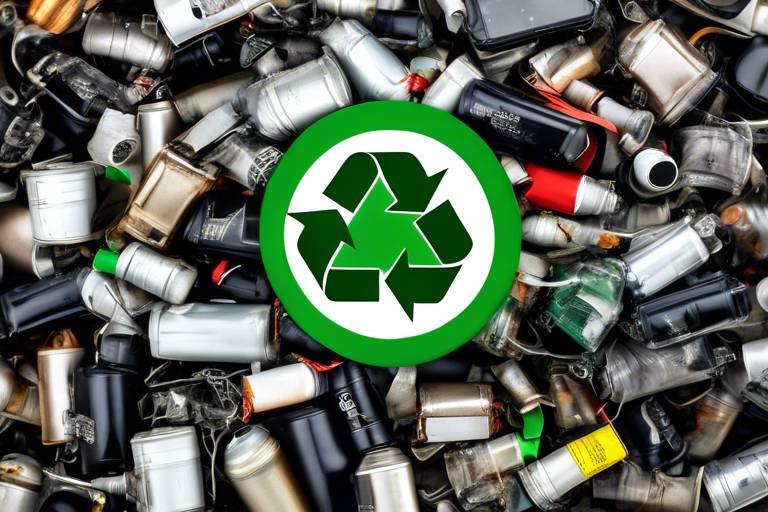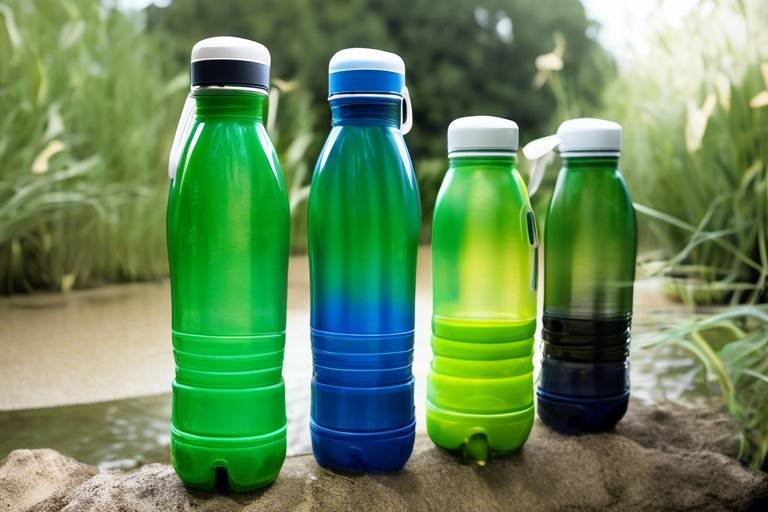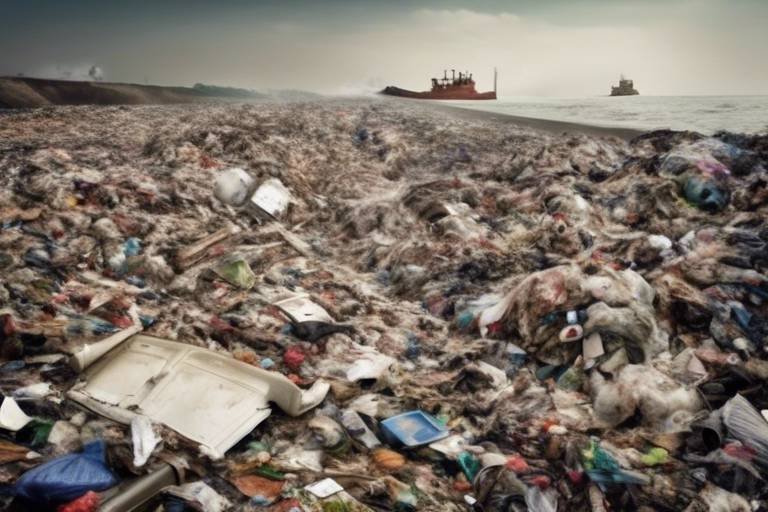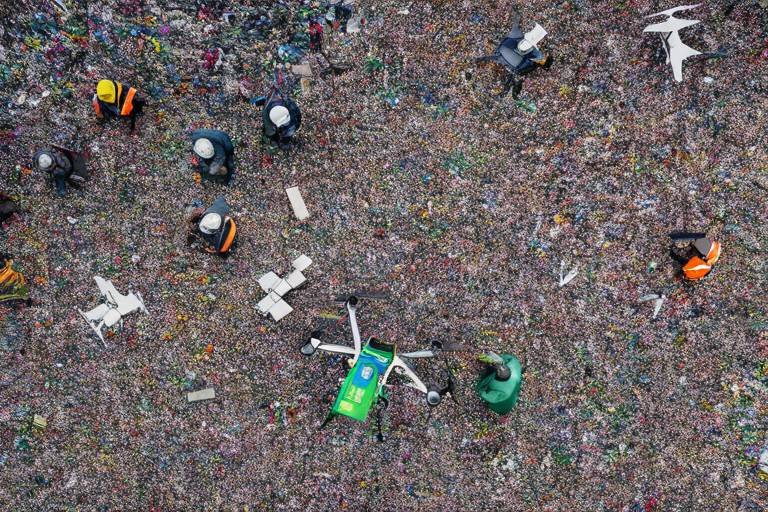Understanding the Difference Between Recyclable and Non-Recyclable Trash
In today’s world, where environmental concerns are at an all-time high, understanding the difference between recyclable and non-recyclable trash is crucial for everyone. It’s not just about tossing things into the right bin; it’s about making informed choices that can lead to a healthier planet. Think of recycling as a superhero for our environment, swooping in to save resources and reduce pollution. But what exactly makes something recyclable or not? Let’s dive deeper into this topic and uncover the secrets behind effective waste management practices.
At its core, recycling is about giving materials a second life. When we recycle, we’re not just reducing the amount of trash that ends up in landfills; we’re also conserving precious natural resources and energy. It’s like turning old clothes into new fashion statements instead of letting them gather dust in the back of your closet. By understanding what can and cannot be recycled, we empower ourselves to make choices that contribute positively to our environment.
So, what is recyclable trash? Generally, it includes materials that can be collected, processed, and turned into new products. This can range from paper and cardboard to metals and glass. Each of these materials has its own recycling journey, and knowing how to sort them correctly can significantly enhance recycling efforts. On the flip side, we have non-recyclable trash, which consists of items that either can’t be processed or are contaminated, making them unsuitable for recycling.
For instance, imagine you’re having a picnic and you accidentally toss your greasy pizza box into the recycling bin. That little mistake can contaminate an entire batch of recyclables, rendering them useless. This is why it’s essential to familiarize ourselves with both categories of trash. By doing so, we can prevent contamination and ensure that recyclable materials are processed correctly.
In the upcoming sections, we’ll explore the importance of recycling, the various types of recyclable materials, and some common non-recyclable items. We’ll also touch on how contamination can affect recycling efforts. Understanding these distinctions will not only help you become a more responsible consumer but also contribute to a more sustainable future for our planet.
Recycling plays a crucial role in conserving natural resources, reducing landfill waste, and minimizing pollution. Understanding its significance helps individuals contribute positively to environmental sustainability.
Various materials can be recycled, including paper, glass, metals, and certain plastics. Identifying these materials is essential for effective recycling efforts and reducing overall waste.
Paper and cardboard are among the most commonly recycled materials. They can be transformed into new products, conserving trees and energy in the process.
Different paper products, such as newspapers, magazines, and office paper, have specific recycling guidelines. Knowing which types are accepted can enhance recycling efficiency.
The recycling process for cardboard involves collection, sorting, and pulping. Understanding this process can encourage proper disposal and recycling habits.
Metals and glass are highly recyclable materials that can be reused indefinitely without losing quality. Their recycling significantly reduces resource extraction and energy consumption.
Many everyday items cannot be recycled due to contamination or material composition. Identifying these items helps reduce waste sent to landfills.
Certain plastics, especially those contaminated with food waste, are often non-recyclable. Understanding contamination issues is vital for effective recycling practices.
Composite materials, such as certain types of packaging and multi-layer products, present challenges for recycling due to their mixed composition. Recognizing these items aids in proper waste sorting.
- What is the most commonly recycled material? Paper is one of the most recycled materials globally.
- Can I recycle pizza boxes? Only if they are clean; greasy boxes are typically non-recyclable.
- What happens to items that cannot be recycled? They usually end up in landfills, contributing to environmental issues.

The Importance of Recycling
Recycling is not just a trendy buzzword; it’s a vital practice that has far-reaching implications for our planet. Imagine a world where our natural resources are preserved, pollution is minimized, and landfills are no longer overflowing with waste. This is the vision that recycling helps to realize. By participating in recycling, individuals can play a significant role in conserving our planet's precious resources and ensuring a healthier environment for future generations.
One of the most compelling reasons to embrace recycling is its ability to conserve natural resources. Every time we recycle materials like paper, metals, and plastics, we're essentially giving them a new lease on life. For instance, recycling just one ton of paper can save up to 17 trees, 7,000 gallons of water, and 4,100 kilowatts of electricity. Isn’t it amazing to think that something as simple as tossing your used paper into a recycling bin can lead to such monumental savings?
Additionally, recycling significantly reduces landfill waste. Landfills are not just unsightly; they contribute to greenhouse gas emissions, which are a major driver of climate change. When organic waste decomposes in landfills, it produces methane, a potent greenhouse gas. By recycling, we can divert materials from landfills, thus reducing their size and the harmful emissions they generate. In fact, studies show that recycling and composting prevented the release of approximately 186 million metric tons of carbon dioxide equivalent into the air in just one year!
Moreover, recycling minimizes pollution. The process of extracting and processing raw materials can be incredibly damaging to the environment, often resulting in air and water pollution. For example, producing new aluminum from bauxite ore generates 95% more greenhouse gas emissions than recycling existing aluminum. When we recycle, we reduce the need for these harmful extraction processes, leading to cleaner air and water. This is crucial not only for our health but also for the health of our ecosystems.
In summary, the importance of recycling cannot be overstated. It conserves natural resources, reduces landfill waste, and minimizes pollution. By understanding the significance of recycling, we empower ourselves to make informed choices that contribute positively to our environment. So next time you're about to toss something in the trash, take a moment to consider whether it could be recycled instead. Your small action can lead to a big impact!
- What materials can be recycled? Most common materials include paper, cardboard, glass, metals, and certain plastics.
- Why are some plastics non-recyclable? Plastics can be non-recyclable due to contamination, mixed materials, or lack of facilities to process them.
- How does recycling help the economy? Recycling creates jobs, conserves resources, and reduces the costs associated with waste disposal.

Types of Recyclable Materials
When it comes to recycling, not all materials are created equal. Understanding the types of recyclable materials is essential for effective waste management and environmental sustainability. By knowing what can be recycled, you can contribute significantly to reducing landfill waste and conserving natural resources. The most commonly recycled materials include paper, glass, metals, and certain types of plastics. Each of these materials has its own recycling process and guidelines, which we'll explore in detail.
Paper and cardboard are among the most frequently recycled materials. They are not only easy to recycle but also have a significant impact on conserving trees and reducing energy consumption. When you recycle paper products, you're essentially giving new life to old materials, which helps in minimizing deforestation. The recycling process starts with collection, followed by sorting, and finally, pulping to create new paper products.
Different types of paper products have specific recycling guidelines. For instance, newspapers, magazines, and office paper can typically be recycled together, but items like pizza boxes or paper towels often cannot be recycled due to contamination. By being aware of these distinctions, you can enhance recycling efficiency and ensure that more materials are processed correctly. The recycling of cardboard involves a similar process, where clean and dry cardboard is collected, sorted, and then pulped to create new cardboard products.
Moving on to metals and glass, these materials are particularly valuable in recycling because they can be reused indefinitely without losing quality. Think about it: recycling aluminum cans and glass bottles significantly reduces the need for raw material extraction, which in turn minimizes energy consumption and greenhouse gas emissions. The recycling process for metals involves melting down the materials and reforming them into new products, while glass recycling entails crushing the glass, which is then melted and molded into new containers.
It's also worth noting that the recycling rates for metals and glass are generally higher than for other materials, thanks to the established infrastructure and consumer awareness. For example, aluminum cans have a recycling rate of over 60%, which is impressive considering the energy savings involved. In fact, recycling a single aluminum can save enough energy to power a television for three hours!
Now, when it comes to plastics, the situation becomes a bit more complex. Not all plastics are recyclable, and the ones that are can vary based on local recycling programs. Commonly accepted recyclable plastics include PET (used in water bottles) and HDPE (used in milk jugs). However, many items such as plastic bags or food containers often end up in the non-recyclable category due to contamination or the type of plastic used. This is why it's crucial to check local guidelines and ensure you're sorting your waste correctly.
In summary, understanding the types of recyclable materials allows us to make informed decisions about waste disposal. By recycling paper, cardboard, metals, glass, and certain plastics, we can play a vital role in conserving our planet's resources and reducing pollution. The next time you're about to toss something in the trash, take a moment to think: can this be recycled? Your small actions can lead to significant environmental benefits.
- What materials can I recycle at home? Most households can recycle paper, cardboard, metals, and certain plastics. Always check your local recycling guidelines.
- Can I recycle food containers? Only if they are clean and dry. Contaminated containers can spoil the recycling process.
- What happens to recycled materials? They are collected, sorted, processed, and then turned into new products, reducing the need for virgin materials.

Paper and Cardboard
When we think about recycling, often come to mind as the heroes of the waste management world. These materials are not just easy to recycle; they are also incredibly valuable in terms of the environmental benefits they offer. Imagine a world where every time you toss a piece of paper into the recycling bin, you're actually saving a tree! That's right; recycling paper can significantly reduce the number of trees cut down for new products. It's like giving nature a big hug every time you recycle!
So, what exactly happens to paper and cardboard once they leave your hands? The recycling process is a well-oiled machine that involves several crucial steps. First, the materials are collected and transported to a recycling facility. Here, they are sorted to remove any contaminants, such as plastic or food waste, which can spoil the entire batch. Once sorted, the paper and cardboard are pulped, breaking them down into fibers. This pulp is then cleaned, de-inked, and dried to create new paper products. It's a fascinating transformation that highlights the importance of proper disposal practices.
Now, let’s dive a little deeper into the types of paper products that can be recycled. Not all paper is created equal, and knowing which types are accepted can make a world of difference. Here are some common paper products that are recyclable:
- Newspapers: A classic staple that can be recycled into new newspapers or other paper products.
- Magazines: Glossy and colorful, magazines can also find new life through recycling.
- Office Paper: This includes printer paper, envelopes, and even sticky notes (without the adhesive).
- Cardboard Boxes: Think about all those online shopping deliveries! Most cardboard boxes can be recycled after a quick flattening.
Understanding the recycling process for cardboard specifically is equally important. Once collected, cardboard is sorted and sent to a pulping facility. Here, it undergoes a similar transformation as paper, but with a few additional steps to ensure the material is clean and ready for reuse. The pulping process involves mixing the cardboard with water and chemicals to break it down. This slurry is then filtered and dried to create new cardboard sheets. It's a cycle that not only conserves resources but also saves energy—recycling cardboard uses about 75% less energy than producing new cardboard from raw materials!
In conclusion, recycling paper and cardboard is a straightforward yet impactful way to contribute to environmental sustainability. By understanding what can be recycled and how the process works, we empower ourselves to make informed decisions. Every little bit counts, and when we all pitch in, we can create a cleaner, greener world for future generations. So the next time you finish reading a magazine or unpack a delivery, remember that your recycling efforts can make a significant difference!
Q1: Can I recycle pizza boxes?
A1: It depends! If the pizza box is clean and free from grease, you can recycle it. However, if it's heavily soiled, it's best to throw it in the trash.
Q2: Are colored paper and cardboard recyclable?
A2: Yes, colored paper and cardboard can generally be recycled, but it's important to check local recycling guidelines as some facilities may have specific restrictions.
Q3: What should I do with shredded paper?
A3: Shredded paper can be recycled, but it should be placed in a paper bag or a cardboard box before being put in the recycling bin to prevent it from getting lost during sorting.
Q4: Is it necessary to remove labels from recyclable containers?
A4: While it's not always necessary, removing labels can help reduce contamination and improve the recycling process. Just make sure to rinse out any food residue!

Types of Paper Products
When it comes to recycling, understanding the different is crucial for maximizing efficiency and minimizing waste. Paper is not just a single entity; it encompasses a variety of products that have unique recycling guidelines. For instance, newspapers, magazines, and office paper are among the most commonly recycled items, but they each have their own specific requirements. Knowing these distinctions can significantly enhance your recycling efforts.
Let's take a closer look at some of these paper products:
- Newspapers: These are typically accepted in most recycling programs. However, it's important to ensure they are dry and free from contaminants like food or grease.
- Magazines: Glossy magazines can also be recycled, but they should be kept separate from regular paper to avoid contamination.
- Office Paper: This includes printer paper, envelopes, and sticky notes. Office paper is highly recyclable, but be cautious of items with plastic windows or heavy ink.
- Cardboard: While often considered a separate category, cardboard is a paper product too. It can be recycled multiple times, provided it's clean and flattened.
Recycling these paper products not only conserves resources but also plays a significant role in reducing landfill waste. In fact, recycling one ton of paper can save approximately 17 trees, 7,000 gallons of water, and 4,100 kilowatts of electricity. That's like powering a home for six months! So, the next time you grab a newspaper or finish a stack of office memos, remember that your actions can have a ripple effect on the environment.
Moreover, the recycling process for paper involves several stages, including collection, sorting, and pulping. During collection, recyclables are gathered from various sources, while sorting ensures that only acceptable materials make it to the pulping stage. This is where the magic happens—paper is turned back into pulp, which can then be used to create new paper products. Understanding this process can encourage you to adopt better recycling habits and ensure that you’re doing your part for the planet.
In essence, being aware of the types of paper products and their recycling requirements not only empowers you as a responsible citizen but also contributes to a more sustainable future. So, the next time you're about to toss that magazine or office paper into the trash, think again! You could be making a significant impact by recycling it instead.
- What types of paper can be recycled? Most paper products, including newspapers, magazines, office paper, and cardboard, can be recycled.
- Are there any paper products that cannot be recycled? Yes, items like paper towels, napkins, and any paper that is contaminated with food or grease are generally non-recyclable.
- How does recycling paper help the environment? Recycling paper conserves natural resources, reduces landfill waste, and decreases pollution from paper production.
- Can I recycle shredded paper? Shredded paper can be recycled, but it's best to check with your local recycling program, as some may not accept it due to sorting challenges.

Cardboard Recycling Process
Recycling cardboard is not just a simple toss into the bin; it involves a fascinating process that transforms used cardboard into new products, making it a crucial component of sustainable waste management. The journey of cardboard recycling can be broken down into several key stages, each playing a vital role in ensuring that this material is reused effectively. Let's dive into the steps involved in this process.
First and foremost, the journey begins with collection. Used cardboard is gathered from various sources such as homes, businesses, and recycling centers. It’s important to ensure that the cardboard collected is clean and free from contaminants like food residue or plastic, as these can hinder the recycling process. Once collected, the cardboard is transported to a recycling facility where it will undergo sorting.
During the sorting phase, workers manually or mechanically separate the cardboard from other materials. This is a critical step because it ensures that only the suitable cardboard is processed. Contaminated or non-recyclable materials are removed, which helps maintain the quality of the recycled product. The sorted cardboard is then compacted into bales, making it easier to handle and transport to the next stage.
The next step is the pulping process. Here, the cardboard is mixed with water and chemicals to break it down into a slurry. This mixture is then agitated, which helps to separate the fibers. The pulp is screened to remove any remaining contaminants, and additional chemicals may be added to enhance the quality of the pulp. Once the pulp is clean and ready, it can be formed into sheets.
After pulping, the slurry is spread onto a flat screen where it is drained to remove excess water, forming a sheet of wet pulp. This sheet is then pressed and dried to create new rolls of recycled cardboard. The final product can then be cut and shaped for various uses, from new boxes to packaging materials. This entire process not only conserves resources but also reduces energy consumption compared to producing new cardboard from virgin materials.
In summary, the cardboard recycling process involves several crucial steps: collection, sorting, pulping, and drying. By understanding this process, we can appreciate the importance of properly disposing of our cardboard waste and contribute to a more sustainable future. Remember, every piece of cardboard you recycle helps save trees, reduce landfill waste, and conserve energy!
- Can I recycle pizza boxes? - Yes, but only if they are clean. If they are greasy or soiled, they should be thrown away.
- What happens to the recycled cardboard? - It is processed and transformed into new cardboard products, helping to conserve resources.
- How can I prepare cardboard for recycling? - Flatten the boxes and ensure they are clean and dry before placing them in the recycling bin.

Metals and Glass
When it comes to recycling, stand out as two of the most valuable materials. Why? Because they can be recycled indefinitely without losing their quality. This means that every time you toss a soda can or a glass bottle into the recycling bin, you're not just getting rid of waste; you're actually contributing to a circular economy that conserves resources and energy. Imagine turning that old aluminum can into a brand-new one, all while saving energy that would otherwise be used to extract and process new materials. It's a win-win!
Let’s dive a little deeper into why recycling these materials is so critical. First, consider metals. Aluminum, for instance, is one of the most recycled materials on the planet. According to the Aluminum Association, recycling aluminum saves up to 95% of the energy required to produce new aluminum from raw materials. That’s like powering a laptop for over five hours just by recycling one can! Similarly, steel is another metal that can be recycled repeatedly. In fact, recycling steel helps reduce greenhouse gas emissions significantly, making it an essential part of our efforts to combat climate change.
Now, let’s talk about glass. Glass is unique because it can be recycled endlessly without losing quality or purity. When you recycle glass, it can be melted down and remolded into new glass products, which not only saves raw materials but also reduces energy consumption. The process is relatively straightforward, involving the collection and sorting of glass by color, followed by cleaning and melting. It's fascinating to think that a glass jar you used for your homemade jam could one day become a new bottle for your favorite beverage!
However, it’s crucial to remember that not all glass is created equal when it comes to recycling. For instance, tempered glass (like that found in car windows) and ceramics cannot be recycled in the same way as standard glass containers. This is where understanding the recycling process becomes essential. By knowing what can and cannot be recycled, you can help ensure that your efforts are effective. So, next time you finish a drink, make sure to rinse out that glass or metal container before tossing it in the recycling bin. It’s a small step that makes a big difference!
| Material | Recycling Benefits |
|---|---|
| Aluminum | Saves 95% energy compared to new production |
| Steel | Reduces greenhouse gas emissions significantly |
| Glass | Can be recycled endlessly without losing quality |
In conclusion, recycling metals and glass is not just an environmental obligation; it's an opportunity to be part of a sustainable future. Every small action counts, and understanding the importance of these materials can inspire us all to make better choices. So, the next time you reach for that recycling bin, remember that you’re not just throwing away trash; you’re participating in a much larger movement toward sustainability and conservation.
- Can all types of glass be recycled? No, only certain types of glass can be recycled effectively. Items like tempered glass and ceramics are typically non-recyclable.
- What happens to recycled metals and glass? They are melted down and remolded into new products, conserving resources and energy.
- How can I ensure my recycling is effective? Rinse out containers and be aware of what materials are accepted in your local recycling program.

Common Non-Recyclable Items
When it comes to recycling, not all waste is created equal. In fact, there are numerous items that simply cannot be recycled, and understanding what these items are is crucial for effective waste management. Why is this knowledge important? Well, improperly sorted trash can lead to contamination of recyclable materials, making them unsuitable for processing. This, in turn, contributes to increased landfill waste and environmental degradation.
One of the biggest culprits of non-recyclable waste is plastic contamination. Many people are surprised to learn that not all plastics can be recycled. For instance, plastics that have been tainted with food residue or grease often end up in the trash instead of the recycling bin. Imagine trying to wash your favorite shirt after spilling a huge bowl of spaghetti sauce on it; it’s a tough job, right? Similarly, when food waste clings to plastic containers, it makes the recycling process much more difficult. To avoid this, it's essential to rinse out containers before tossing them into the recycling bin.
Another category of non-recyclable items includes composite materials. These are products made from a combination of different materials, such as certain types of packaging and multi-layer products. Think of juice cartons that have a mix of paper, plastic, and aluminum. While they might seem recyclable at first glance, their mixed composition complicates the recycling process. It’s like trying to put together a jigsaw puzzle with pieces from different sets—frustrating and nearly impossible! Recognizing these composite materials can significantly aid in proper waste sorting.
Additionally, some common household items that are often overlooked include:
- Pizza boxes: While cardboard is generally recyclable, those greasy pizza boxes are usually a no-go.
- Styrofoam: This lightweight foam material is notorious for being non-recyclable and often ends up polluting our oceans.
- Plastic bags: Many people are unaware that plastic grocery bags can’t be recycled in curbside bins. They often get tangled in recycling machinery, causing delays and damage.
In summary, recognizing non-recyclable items is essential for fostering a more sustainable future. By being mindful of what goes into our recycling bins, we can reduce contamination and ensure that recyclable materials are processed correctly. This not only helps in conserving resources but also plays a significant role in reducing the amount of waste that ends up in landfills, thereby protecting our planet for future generations.
Q: Can I recycle pizza boxes?
A: Unfortunately, pizza boxes that are greasy or contaminated with food waste are generally not recyclable. It's best to dispose of them in the trash.
Q: What should I do with plastic bags?
A: Plastic bags should not be placed in curbside recycling bins. Instead, many grocery stores have designated bins for recycling plastic bags.
Q: Are there any types of plastics that can be recycled?
A: Yes, certain plastics are recyclable, typically those marked with recycling codes #1 (PETE) and #2 (HDPE). Always check with your local recycling guidelines.

Plastic Contamination
When we think about recycling, plastic often comes to mind as one of the most challenging materials to deal with. Why is that? The answer lies in the concept of . This term refers to the presence of unwanted substances on or within recyclable plastics, which can hinder the recycling process. Imagine trying to bake a cake, but someone keeps tossing in random ingredients like salt instead of sugar. The result is a disaster! Similarly, contaminated plastics can ruin entire batches of recyclable materials, leading to increased waste and environmental harm.
One of the main culprits of plastic contamination is food waste. Think about it: a takeout container that still has remnants of last night's dinner is not just an eyesore; it can also render that container non-recyclable. When these containers find their way into recycling bins, they can contaminate other clean plastics, making them unsuitable for recycling. In fact, the recycling facilities often have to discard large amounts of contaminated materials, which means more waste ends up in landfills.
To better understand the impact of plastic contamination, let's consider some common scenarios:
| Type of Plastic | Common Contaminants | Recycling Outcome |
|---|---|---|
| Food containers | Leftover food, grease | Often non-recyclable due to contamination |
| Plastic bags | Debris, mixed materials | Can clog machinery, often not accepted |
| Plastic bottles | Labels, residue | Can be recycled if cleaned properly |
So, what can we do to combat plastic contamination? First and foremost, it's essential to rinse out any food containers before tossing them into the recycling bin. A quick rinse can make a world of difference! Additionally, being mindful of the type of plastics we use can also help. For instance, opting for single-material packaging can reduce the risk of contamination, as these materials are often easier to recycle.
In summary, plastic contamination is a significant barrier to effective recycling. By understanding the importance of keeping plastics clean and free from contaminants, we can all play a part in enhancing recycling efforts. Remember, every small action counts! So the next time you finish a meal, take a moment to rinse that container before recycling it. Together, we can make a substantial impact on our planet's health.
- What types of plastics are most commonly contaminated? Food containers, plastic bags, and bottles are the most common culprits.
- Can I recycle plastic containers with food residue? Generally, no. Containers should be rinsed clean before recycling to avoid contamination.
- What happens to contaminated plastics? They are often rejected by recycling facilities and end up in landfills.

Composite Materials
Composite materials are fascinating yet challenging when it comes to recycling. These materials combine two or more distinct substances to create a product with enhanced properties, often making them ideal for various applications. Think of composite materials as the superheroes of the material world; they possess the strengths of their individual components while minimizing weaknesses. However, this very combination is what complicates their recyclability. Unlike single-material products, composites can be made from plastics, metals, and even organic materials, which complicates the recycling process.
For instance, consider the popular packaging used for snacks or beverages. These often consist of layers of plastic, aluminum, and paper, all glued together to create a barrier that preserves freshness. While this design is excellent for keeping products safe and extending shelf life, it poses a significant challenge for recycling facilities. When these composite materials reach a recycling plant, they often cannot be separated efficiently, leading them to be classified as non-recyclable waste. This is akin to trying to separate a well-mixed salad; once combined, the individual ingredients lose their identity and purpose.
To better understand the challenges posed by composite materials, let's take a look at some common examples:
- Multi-layer packaging: Used for items like juice boxes or chip bags, often made from a combination of plastic and aluminum.
- Composite wood products: Such as particleboard, which is made from wood fibers and adhesives, making it difficult to recycle.
- Electronics: Many electronic devices contain composite materials that combine metals and plastics, complicating the recycling process.
Recognizing composite materials is crucial for effective waste management. By being aware of what constitutes a composite product, individuals can make informed decisions about disposal. For example, rather than tossing a snack wrapper into the recycling bin, it might be better to dispose of it in the regular trash to prevent contamination of recyclable materials. This small change in behavior can significantly impact the efficiency of recycling programs.
In conclusion, while composite materials serve essential functions in our daily lives, their complex nature makes them a significant hurdle in recycling efforts. Awareness and education about these materials can empower consumers to make better choices, ultimately contributing to a more sustainable future. Remember, every little bit counts, and understanding what can and cannot be recycled is a step in the right direction!
Q: Why are composite materials difficult to recycle?
A: Composite materials are challenging to recycle due to their mixed composition, which often includes different types of plastics, metals, and other substances that cannot be easily separated during the recycling process.
Q: What should I do with composite materials?
A: It's best to dispose of composite materials in the regular trash unless your local recycling program specifically accepts them. Always check your local guidelines for recycling to ensure proper disposal.
Q: Can composite materials be made recyclable?
A: While some advances in technology may allow for the recycling of certain composite materials, many still present significant challenges. Research is ongoing to develop better methods for recycling these materials.
Frequently Asked Questions
- What is the difference between recyclable and non-recyclable trash?
Recyclable trash consists of materials that can be processed and turned into new products, like paper, glass, and certain plastics. Non-recyclable trash, on the other hand, includes items that cannot be reused in the recycling process, often due to contamination or material composition, such as food waste or composite materials.
- Why is recycling important?
Recycling is essential because it helps conserve natural resources, reduces landfill waste, and minimizes pollution. By recycling, we can lower the demand for new materials, which in turn reduces energy consumption and environmental impact. It's a simple way for individuals to contribute to a more sustainable future!
- What materials can I recycle?
You can recycle a variety of materials, including:
- Paper and cardboard
- Metals, such as aluminum and steel
- Glass containers
- Certain plastics (check local guidelines)
Identifying these materials is crucial for effective recycling efforts and reducing overall waste.
- How should I prepare my recyclables?
To prepare your recyclables, make sure to:
- Rinse out food containers to avoid contamination.
- Flatten cardboard boxes to save space.
- Keep items clean and dry.
Following these steps ensures that your recyclables are accepted and processed efficiently!
- What are some common non-recyclable items?
Common non-recyclable items include:
- Plastic bags and wraps
- Polystyrene foam (like takeout containers)
- Food-contaminated items
- Composite materials, such as multi-layer packaging
Knowing these items can help you reduce waste sent to landfills.
- What happens if I mix recyclables with non-recyclables?
Mixing recyclables with non-recyclables can contaminate the recycling stream, making it harder to process the materials. This can lead to more waste being sent to landfills instead of being recycled, which defeats the purpose of your efforts!
- How can I encourage others to recycle?
Encouraging others to recycle can be as simple as:
- Sharing information about the benefits of recycling.
- Setting up recycling bins in convenient locations.
- Leading by example and practicing good recycling habits yourself.
Sometimes, all it takes is a little nudge to get others on board!




